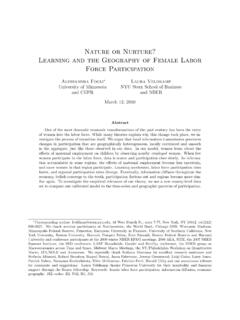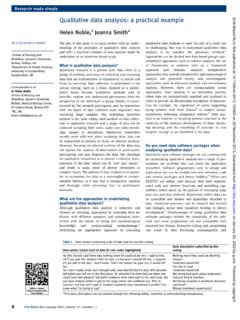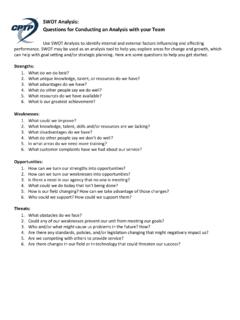Transcription of COMPETITOR ANALYSIS - pages.stern.nyu.edu
1 COMPETITOR ANALYSIS . John A. Czepiel Professor of Marketing and Stern Teaching Excellence Fellow Leonard N. Stern School of Business New York University New York, New York 10012. Telephone: (212) 998-0510. e-mail: and Roger A. Kerin Harold C. Simmons Distinguished Professor of Marketing Edwin L. Cox School of Business Southern Methodist University Dallas, Texas 75275. Telephone: (214) 768-3162. e-mail: COMPETITOR ANALYSIS . Competitive marketing strategies are strongest either when they position a firm's strengths against competitors' weaknesses or choose positions that pose no threat to competitors. As such, they require that the strategist be as knowledgeable about competitors' strengths and weaknesses as about customers'. needs or the firm's own capabilities.
2 This chapter is designed to assist the strategist understand how to gather and analyze information about competitors that is useful in the strategy development process. It discusses the objectives of COMPETITOR ANALYSIS and proceeds through the processes involved in identifying important competitors and information needs, gathering necessary information, and interpreting this information. THE OBJECTIVES OF COMPETITOR ANALYSIS . The ultimate objective of COMPETITOR ANALYSIS is to know enough about a COMPETITOR to be able to think like that COMPETITOR so the firm's competitive strategy can be formulated to take into account the competitors' likely actions and responses. From a practical viewpoint, a strategist needs to be able to live in the competitors' strategic shoes.
3 The strategist needs to be able to understand the situation as the competitors see it and to analyze it so as to know what actions the competitors would take to maximize their outcomes to be able to calculate the actual financial and personal outcomes of the COMPETITOR 's strategic choices. They must be able to: 1. Estimate the nature and likely success of the potential strategy changes available to a COMPETITOR ;. 2. Predict each COMPETITOR 's probably responses to important strategic moves on the part of the other competitors; and 3. Understand competitors' potential reactions to changes in key industry and environmental parameters. What then should one expect from COMPETITOR ANALYSIS ? Underneath all of the complexities and depth of COMPETITOR ANALYSIS are some simple and basic practical questions, of which the following are typical: Which competitors does our strategy pit us against?
4 Which COMPETITOR is most vulnerable and how should we move on its customers? 1. Is the COMPETITOR 's announced move just a bluff? What's it gain if we accept it at face value? What kind of aggressive moves will the COMPETITOR accept? Which moves has it always countered? IDENTIFYING COMPETITORS. Identifying competitors for ANALYSIS is not quite as obvious as it might seem. Two complementary approaches are possible. The first is demand-side based, comprised of firms satisfying the same set of customer needs. The second approach is supply-side based, identifying firms whose resource base, technology, operations, and the like, is similar to that of the focal firm. However, the firm must pay attention not only to today's immediate competitors but also to those that are just over the horizon (such as cellphones once were to cameras, social networking sites once were to web portals, or the internet once was to video rental stores).
5 There are three domains for recognizing the sources and types of direct and less direct competitors to which the firm must also attend. These domains represent (1) the areas of influence, (2) the contiguous area, and (3) the areas of The area of influence is the territory, market, business, or industry in which the firm is directly competing with other firms to serve the same customer needs using the same resources. It is the arena in which Ford, Honda, Toyota, Kia, and General Motors compete with each other; where Nokia competes with Samsung and Motorola in cellphones. These are a firm's direct competitors. Immediately contiguous areas are those in which competition is close but indirect;. comprising those firms that serve the same customer need but with different resources.
6 Many food products fit into this category such as snack foods (potato chips versus pretzels versus peanuts), or packaging (glass versus plastic versus aluminum). They may serve the same need but through differing distribution channels (direct such as Avon versus retail such as Revlon). These are a firm's indirect competitors. Areas of interest are composed of firms that do not currently serve the same customer base but have the same resource base or, in broader terms, have capability equivalence the ability to satisfy similar customer For 1. William L. Sammon, Mark A. Kurland, and Robert Spitalnic, Business COMPETITOR Intelligence: Methods for Collecting, Organizing, and Using Information. John Wiley and Sons, 1984; Mark Bergen and Margaret A. Peteraf, COMPETITOR Identification and COMPETITOR ANALYSIS : A Broad-Based Managerial Approach, Managerial and Decision Economics 23, (June-August 2002): 157-169; Bruce H.
7 Clark and David B. Montgomery, Managerial Identification of Competitors, . Journal of Marketing, (July 1999), 67-83. 2. Margaret A. Peteraf and Mark E. Bergen, Scanning Dynamic Competitive Landscapes: A Market-Based and Resource- Based Framework, Strategic Management Journal 24, 2003, 1027-1041. 2. example, many firms possess the necessary capabilities to produce a wide range of digital electronic devices whether cell phones, PDAs, cameras, or pad . computers. These comprise a firm's potential competitors. We will first examine product/market level competition serving the same needs to the same customer group. Next we will examine firm-level competition. Identifying Competitors at the Product-Market Level The most direct COMPETITOR competes for the exact same customers in exactly the same way as the subject firm.
8 It sells the same product made by the same technology to the same customers via the same marketing channels. If the firm cannot win customer patronage versus such an identical COMPETITOR , then it is unlikely that it can do any better competing against its indirect or potential competitors. Why? If the firm's exact counterpart can win in direct competition, then that same COMPETITOR should also win more against the less direct competitors. Companies, per se, do not compete with each other in the marketplace. Rather, their individual businesses compete with each other. The strategic marketing literature denotes a business as a division, product line, or other profit center with a company that produces and markets a well-defined set of related products and/or services, serves a clearly defined set of customers, and competes with a distinct set of A business is further defined in terms of a number of key dimensions, which reflect the ways and places in which it has chosen to compete.
9 Primary among these are the products it offers and the types of customers to whom it chooses to sell. The products a firm offers can be defined along three dimensions: functions, technology, and materials: Customer function is concerned with what need is being satisfied. This is the most natural way to think about a product. Electromechanical devices, for example, can frequently be designed to satisfy any size set of functions from very narrow to very wide. For example, some cooking appliances are single function (microwave ovens), others are dual function (combination convection-microwave ovens), while others are multifunction (combination convection-microwave-conventional ovens). Another example concerns over-the-counter medications which, although identical in ingredients, may be positioned or sold for the 3.
10 Roger A. Kerin, Vijay Mahajan, and P. Rajan Varadarajan, Contemporary Perspectives on Strategic Market Planning. Boston: Allyn & Bacon, 1990. 3. relief of colds or allergies or sinus symptoms. Others, such as Nyquil, are sold for even more specific usage applications (night-time cold relief). Technology tells how the customer function(s) are being satisfied. For example, kitchen ranges may use two sources of thermal energy (gas or electric) or, alternatively, microwave energy to cook. X rays, computerized axial tomography (CAT scan machines), and NMR (nuclear magnetic resonance) are three different technologies used in medical diagnostic imaging. The materials used in the manufacture of the product may also differ, producing slight differences in products that are otherwise identical.

















